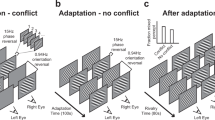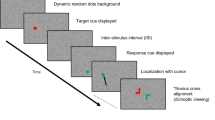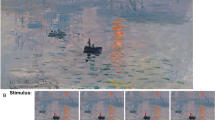Abstract
STEREOSCOPIC depth perception can coexist with binocular rivalry of form and colour1–3. If a stereogram is viewed with a red filter in front of one eye and a green filter in front of the other eye (or with an oblique grating superimposed on one eye's picture and an orthogonal grating on the other picture), then stereopsis can still be obtained in spite of the two eyes' pictures being seen alternately rather than simultaneously. Although one image is ‘suppressed’ in consciousness, information about its position is preserved and used for stereopsis. This finding implies either that stereoscopic depth perception ‘precedes’ the site of binocular rivalry in the visual system or that conscious perception and stereopsis are independent visual functions mediated in ‘parallel’ neural channels. Here I consider the related question of whether an image that is suppressed during binocular rivalry (and is, therefore, not ‘seen’ by the observer) can contribute to the perception of apparent movement.
This is a preview of subscription content, access via your institution
Access options
Subscribe to this journal
Receive 51 print issues and online access
$199.00 per year
only $3.90 per issue
Buy this article
- Purchase on Springer Link
- Instant access to full article PDF
Prices may be subject to local taxes which are calculated during checkout
Similar content being viewed by others
References
Treisman, A., Q. Jl exp. Psychol., 14, 23 (1962).
Kaufman, L., Am. J. Psychol., 77, 193 (1964).
Ramachandran, V. S., Rao, V. M., and Vidyasagar, T. R., Nature, 242, 412 (1973).
Kolers, P. A., Vision Res., 12, 1057 (1972).
Helmholtz, H. Von, Treatise on Physiological Optics, III (edit. by Southall, J. P. C. S.), (Dover, New York, 1962).
Ramachandran, V. S., Rao, V. M., and Vidyasagar, T. R., Vision Res., 13, 1399 (1973).
Sigman, E., and Rock, I., Perception, 3, 9 (1974).
Anstis, S. M., Vision Res., 10, 1411 (1970).
Julesz, B., Foundations of Cyclopean Perception (University of Chicago Press, Chicago and London, 1971).
Braddick, O., Vision Res., 14, 519 (1974).
Author information
Authors and Affiliations
Rights and permissions
About this article
Cite this article
RAMACHANDRAN, V. Suppression of apparent movement during binocular rivalry. Nature 256, 122–123 (1975). https://doi.org/10.1038/256122a0
Received:
Accepted:
Issue Date:
DOI: https://doi.org/10.1038/256122a0
Comments
By submitting a comment you agree to abide by our Terms and Community Guidelines. If you find something abusive or that does not comply with our terms or guidelines please flag it as inappropriate.



